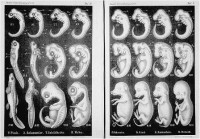Seminar by Dr. Kurt Wise Seattle Creation Conference May 31, 2014 Woodin Valley Baptist Church, Bothell WA. Description: Plant divisions appear in the order in the fossil record that is predicted by evolution, making them one of the most powerful evidences of megaevolutionary theory. The same order can be explained by postulating the destruction during the Flood of a continent-sized floating forest. The development of floating forest theory provides an example of how creationism can generate good theories (explaining more data than evolution, while also being synthetic, predictive, and heuristic). About the Speaker: Kurt Wise earned a B.A. in Geophysical [More]
Our featured speaker on Creation Weekend (Sept 10, 2010) was Dr. Raymond G. Bohlin, a well-known speaker and author, who is President of Probe Ministries. Dr. Bohlin was born and raised in Chicago, IL and is a graduate of the University of Illinois (B.S., zoology, 1971-1975), the University of North Texas (M.S., population genetics, 1977-1980), and the University of Texas at Dallas (M.S., Ph.D., molecular and cell biology, 1984-1991). Dr. Bohlin has many articles and publications, ranging from molecular biology to Christian apologetics, such as stem cell research and the ethics of human cloning. He has as lectured and debated [More]
Our featured speaker on Creation Weekend (Sept 10, 2010) was Dr. Raymond G. Bohlin, a well-known speaker and author, who is President of Probe Ministries. Dr. Bohlin was born and raised in Chicago, IL and is a graduate of the University of Illinois (B.S., zoology, 1971-1975), the University of North Texas (M.S., population genetics, 1977-1980), and the University of Texas at Dallas (M.S., Ph.D., molecular and cell biology, 1984-1991). Dr. Bohlin has many articles and publications, ranging from molecular biology to Christian apologetics, such as stem cell research and the ethics of human cloning. He has as lectured and debated [More]
The Melanophila beetle is one of many creatures that actually hunt for fires. In fact, its heat-sensing skills may offer insights into developing better weapons technology. …read more Read more here: AIG Daily
This nurse shark refuses to eat fish or meat. She uses her razor-sharp, serrated teeth to pulp broccoli and cabbage instead. …read more Read more here: creation.com
By Creation Moments The electron microscope was developed over 80 years ago and enables us to probe the secrets of God’s creation. One of the most surprising discoveries shows an incredible similarity between those little whips called flagellum – which some microbes use for swimming – and the inside of your ear! read more …read more Read more here: Creation Moments
“The incredible process of metamorphosis, changing a caterpillar to the beautiful monarch, is astounding in it’s complexity and defies any evolutionary explanation. It is one of the most powerful arguments for creation I know of.” Admin A monarch’s development from caterpillar to adult and its incredible ability to migrate clearly display the Creator’s design. What animal has a brain the size of a pinhead and yet can pinpoint a location 3,000 miles (4828 km) away and navigate there with an accuracy of 100 feet (30.5 m)?1 It is the most famous butterfly in North America—the monarch. But the winged adult [More]
By Creation Moments In 1866, Professor Ernst Haeckel, a German zoologist and strong supporter of Darwin, published his theory that every developing embryo recapitulates all the previous evolutionary stages of its species. So the human embryo began as a fish with gills, then became frog-like, and so on until at the ninth month it was fully human. read more …read more Read more here: Creation Moments
“One more marvel of design that clearly testifies to Gods handiwork.” Admin Bees can solve complex mathematical problems that would normally keep computers busy for days, according to a new report from UK researchers.1 Through careful observation, University of London scientists have determined that bees routinely solve the “traveling salesman problem,” in which a subject must determine the shortest route between multiple destinations in order to conserve energy. But the scientists don’t know how the bees do it with a brain the size of a grass seed. “Bees learn to fly the shortest possible route between flowers even if they [More]
“In this session Dr. Jeanson discusses what genetic evidence shows regarding the existence of a real Adam and Eve. You can read an article dealing with this topic here plus an article about the supposed genetic similarity between chimps and man here“. Admin At the 2014 Creation Conference held February 21-23 at Cliffwood Presbyterian Church, Dr. Nathaniel Jeanson of the Institute for Creation Research gave a series of talks defending the literal reading of the creation account in Genesis. This is the fourth talk entitled, “Adam & Eve Meet Genetics.”
“In this session Dr. Jeanson discusses 4 arguments given for evolution and where evolutionists interpretations of these arguments fail ” Admin At the 2014 Creation Conference held February 21-23 at Cliffwood Presbyterian Church, Dr. Nathaniel Jeanson of the Institute for Creation Research gave a series of talks defending the literal reading of the creation account in Genesis. This is the third talk entitled, “The Scientific Failure of Darwinian Evolution.”
“In this session Dr. Jeanson discusses the design which is seen throughout nature with emphasis on design in the cell and how it clearly points to intelligence.” Admin At the 2014 Creation Conference held February 21-23 at Cliffwood Presbyterian Church, Dr. Nathaniel Jeanson of the Institute for Creation Research gave a series of talks defending the literal reading of the creation account in Genesis. This video is the 2nd session: Glimpsing the Mind of God.
“I’ve posted a number of these articles about marvels of design which occur throughout nature yet no matter how many examples are given evolutionists still insist they are just products of blind random chance … how foolish can you get.” Admin For decades, human design engineers have been laboring to make more efficient machines, like propeller blades that produce steady airflow patterns. Our thinking has been fixed on the idea that smooth surfaces are the best basic form, but studies on whales and dolphins are changing that. A whale flipper has a bumpy edge. After incorporating some bumpy, irregular features into [More]
A research team recently characterized a group of genes in humans and other mammals that not only defies evolutionary models but vindicates the Bible’s prediction of the uniqueness of created kinds with distinct genetic features. More… …read more Read more here: icr.org
Sep 8, 2008 … A gecko foot encased in amber has been dubbed the oldest gecko fossil ever discovered, according to researchers from Oregon State University and the Natural History Museum in London.1 The amber deposits containing the remarkably well-preserved fossil, discovered in Myanmar, are said to be around 100 million years old, which would double the “date” of the earliest-known gecko, making it “43 to 56 million years older” than the prior record holder.2 The discovery has been given the customary evolutionary interpretation, but the evidence presented by this gecko foot actually fits much better within a biblical creation [More]
Creation scientists say new genetic findings challenge the evolutionary model and show that humans and chimps did not evolve from a common ancestor. Scientists from MIT and the University of Massachusetts Medical School recently published a report in the journal Genome Research entitled “Evolutionary dynamics and tissue specificity of human long noncoding RNAs in six mammals.” The article compares human long intergenic noncoding RNAs (lincRNAs) with lincRNAs of several mammals—including chimps and rhesus monkeys. According to experts, lincRNAs are critically important to cells’ existence and serve many different roles. Not only are lincRNAs found within cells’ nuclei and cytoplasm, but [More]
Do monitor lizards and crocodiles really breathe the same way birds do? …read more Read more here: AIG Daily
“Another incredible marvel of design that only an intelligence far greater than ours could have produced.” Admin Human eyes are well-designed to see objects using light transmitted through air, but not through water, because light travels at a different speed through the two media. However, intertidal-dwelling marine mollusks called chitons can see equally well in both environments. How did they acquire this unusual ability? Chitons scour intertidal rocks for algae meals. Eight integrated shell-plates cover their backs, and a muscular foot allows them to cling with surprising strength to the rocks they traverse. A recent study explored their unique dual-mode [More]
The human hand is undeniably a work of wonder. Its layout and suite of design features enable mankind,the only possessors of this particular arrangement of bones, tendons, muscles, and nerves,to type faster than 60 words per minute or swing a heavy hammer while holding a delicate potato chip. What would it take to duplicate a human hand? A series of robotic facsimiles of human hands have been developed, but none have approached the range of functions of the original. The latest and most advanced robot hand was recently described in the journal Smart Materials and Structures by two Virginia Polytechnic [More]
“Another marvel of design that confounds evolutionists.” Admin Animal and human life depends, either directly or indirectly, on plant life. And all plant life depends on extraordinarily precise biochemical machines that capture and convert light energy into energy that living cells can use. Researchers at the Argonne National Laboratory in Illinois have been using ultrafast spectroscopy to discover just how these systems work. Their most recent discovery has them baffled over the newfound complexity of photosynthesis in purple bacteria. It turns out that their photosynthetic machinery is such advanced technology that it takes advantage of the quantum nature of light. [More]
For the amazing echolocation ability of bats to function properly, both emitting and receiving organs must be present, and cooperate. (There are other problems too, to drive evolutionists ‘batty’.) …read more Read more here: creation.com
By Creation Moments In 1835, when scientists first saw Peru’s most unusual hummingbird, they were so overcome with its beauty that they gave it the name “Marvellous”. read more …read more Read more here: Creation Moments
Evolution textbooks have said for years that placental mammals didn’t appear until after dinosaurs went extinct. But now many are saying that’s wrong. …read more Read more here: creation.com
“Once again man is copying one of the marvels of design in Gods creation.” Admin Harvard’s Wyss Institute specializes in designing new materials and devices that mimic patterns found in living things. Their latest contribution was inspired by the versatile material found in insect cuticle, which is strong and flexible, yet remarkably lightweight. The result was “shrilk,” a moldable, biodegradable substance derived from shrimp shells and silk that is as strong as some aluminum alloys but only half their weight. “Shrilk could be used to make trash bags, packaging, and diapers that degrade quickly,” according to a Wyss Institute press [More]
It’s all so slick in the evolutionary storytelling world, especially with one of its icons Tiktaalik roseae. Tiktaalik is a fish supposedly 3751 million years old which has been promoted as a transitional fossil in sea-to-land evolution. Tiktaalik has its own website2 and was even the theme of a song to promote evolution with the repeated line, “tik, tik, tik, tik, Tiktaalik.”3 The Tiktaalik story began in 2004 when University of Chicago researchers found a fossilized skull (not a fully formed fish) in Canada. More remains were found at the same locality on Ellesmere Island in 2006, 2008 and 2013 [More]
“The honeybee’s guidance system and waggle dance it does to communicate to other bees how to get to the nectar are complex marvels of design. Another testimony to God’s handiwork.” Admin Polarized light imprints GPS directions on the honeybee brain’s genes. The uncanny ability of honeybees to remember and communicate the location of sweet nectar has been the subject of ongoing investigations—both navigational and genetic. “The more we find out how honeybees make their way around the landscape, the more awed we feel at the elegant way they solve very complicated problems of navigation that would floor most people—and then [More]
100 Years of Fruit Fly Tests Show No Evolution http://www.icr.org/article/5532/ July 22, 2010, marked the 100th anniversary of genetic investigations using fruit flies. The first such study appeared in Science in 1910 and described the unexpected appearance of a male fruit fly with white eyes after generations of flies with pigmented eyes.1 This began a century of focused studies on fruit fly mutations, but what has really been learned by all this tinkering? For most of the past century–and especially since the discovery of DNA as a physical molecule carrying heritable information–the prevailing concept of neo-Darwinian evolution has held mutations [More]




























